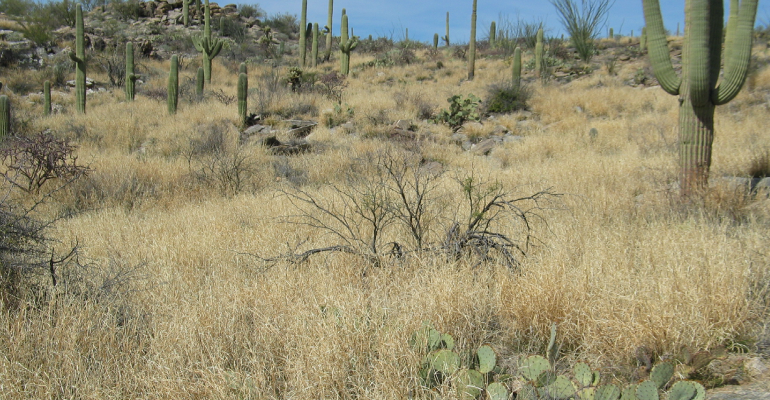
On July 14 Saguaro National Park announced public meetings prior to their resuming aerial spraying of glyphosate, the active ingredient in Monsanto’s Roundup. Glyphosate was labeled a “probable carcinogen” by the World Health Organization’s International Association for Research on Cancer in 2015 based on an exhaustive review of scientific studies. Aerial spraying by the park in 2014 sickened people living near the Panther Peak spray area, as did Tucson Water’s cropduster-type spraying of its Avra Valley lands.
The East Side meeting will be at the Rincon Mountain District Fire Conference Room on July 19, located at 12661 E. Broadway Blvd. A presentation will also take place at the Environmental Education Center at Tucson Mountain District, next to the Red Hills Visitor Center, on July 20. Each presentation will start at 5:00 pm. according to the park’s press release.
With summer monsoon rains comes the greening up of buffelgrass, a non-native invasive bunchgrass that chokes out native plants and creates a serious fire hazard. Buffelgrass was widely planted as cattle forage and erosion control before being banned as a “noxious pest” in Arizona. New and hardier varieties are still being developed and marketed in Texas and Sonora, and climate change is increasing its range.
And with buffelgrass growth has come aerial spraying of controversial pesticides that have sickened local residents. Buffelgrass is tenacious, with deep roots. Removal by hand is labor-intensive, and only glyphosate, the active ingredient in Monsanto’s Roundup, seems to kill it. The pesticide must, however, be applied during the wet greening-up period. In addition to backpack sprayers and trucks, cropduster airplanes and helicopters are being used to spread the poison locally.
The World Health Organization labeled glyphosate a “probable” cause of cancer. There is a non-Hodgkins lymphoma blood cancer cluster among regular users of glyphosate in the agricultural industry. The European Union was unable to agree last month on relicensing glyphosate for the normal 15 years and did so for only 18 months, pending further study. The EU also put restrictions on its use, especially in public areas. It has already been banned or restricted in a number of countries and U.S. localities.
The U.S. Environmental Protection Agency is reviewing its approval of glyphosate amid reports, after Freedom of Information Act disclosures to The Intercept, that 27 of the 32 studies relied on to declare glyphosate safe were funded by the pesticide industry, including manufacturers Monsanto and Sygenta. Three of the five independent studies found adverse effects on reproductive systems.
A growing number of independent studies not looked at by the EPA are confirming the dangers of glyphosate exposure. Recent research also shows that “inert ingredients” used with glyphosate, like POE-tallowamine, damage the human endocrine system. The European Union’s restrictions include a ban on use of the adjuvant. A May, 2016, report from Peru found 92 children and three teachers sickened with extreme vomiting in a school near a field being sprayed with glyphosate.
Similar symptoms have been reported by residents of the Avra Valley near aerial spraying by Saguaro National Park in the Panther Peak area, and near Tucson Water’s valley holdings. Glyphosate runoff after a storm is also suspected as the killer of cattle forage on a nearby rancher’s property. Glyphosate is a major cause of the decline in the national monarch butterfly population. The pesticide kills milkweed, the monarch caterpillar’s food source. Glyphosate is also a major suspect in the Colony Collapse Disorder that has decimated pollinator bee populations.
This will be third year Saguaro National Park plans aerial spraying by helicopter, despite problems with controlling spray drift. A report from Park Restoration Ecologist Dana Backer to the Southwest Vegetative Management Association after the park’s initial 2014 spraying noted that controls to limit spray drift away from the target areas did not always work. Backer’s PowerPoint presentation stated:
“Equipment cannot be calibration (sic) on the fly (8 ft. boom), system needs to purge at end of load and rinsate loads,” and they had to “accept overlap of spray swaths.” The results were heavier-than-planned concentrations of glyphosate which led to drift out of the target area and making neighbors sick.
At a peaceful protest by Avra Valley residents at the Park’s Red Hills Visitor Center last summer park staff denied that Backer had said those things. Backer’s presentation, however, is still available on the Southern Arizona Buffelgrass Coordinating Committee’s website, http://www.buffelgrass.org/sites/default/files/Buffelgrass%20Control%20Takes%20to%20the%20Air_v3.pdf. See page 38, “Lessons Learned.”
Tucson Water sprays the buffelgrass it planted in the Avra Valley regularly with cropduster-type airplanes. They have sprayed up to 200 feet from the home of area residents who, with their dog, became sick after the spraying. Concerns from the Avra Valley Coalition and others prompted inquiries from Tucson Water’s Citizens Water Advisory Committee .
That has resulted in a notification system that area residents say is inadequate, but is a start. Spray areas will be flagged and there will be written notices of the general time frame for spraying, with a contact phone number. The specific day of spraying, however, will not be announced. Residents are asking for automated calling on the day of spraying so they can leave or hunker down.
State Representative Vince Leach from L.D. 11 has been working with Avra Valley activists to reduce the threat from aerial spraying. State Department of Agriculture regulations prohibit pesticide spraying that drifts onto neighboring private property and its human or animal inhabitants. If such drift occurs, the DOA’s Pesticide Management Complaints hotline should be called immediately: 602-541-0901, or 800-423-8876.
No data has yet been released by any of the agencies as to effects of glyphosate on wildlife and native plants in spray areas. In the Panther Peak area, deemed “not accessible” by the park, hikers have reported seeing desert tortoises, ground-nesting great horned owls, and tiger rattlesnakes, none of which would be visible from the air.
Contact: Albert Lannon 520-622-3561 albertlannon@powerc.net
